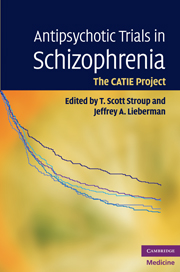Crossref Citations
This Book has been
cited by the following publications. This list is generated based on data provided by Crossref.
Lieberman, Jeffrey A.
and
Stroup, T. Scott
2011.
The NIMH-CATIE Schizophrenia Study: What Did We Learn?.
American Journal of Psychiatry,
Vol. 168,
Issue. 8,
p.
770.
Lieberman, Jeffrey A.
and
Stroup, T. Scott
2012.
The NIMH-CATIE Schizophrenia Study: What Did We Learn?.
Focus,
Vol. 10,
Issue. 2,
p.
226.
Bahorik, Amber L.
Queen, Courtney C.
Chen, Shuangzhou
Jackson Foster, Lovie J.
and
Bangs, Ralph L.
2015.
Racial Disparities in Community Outcomes Among Individuals with Schizophrenia and Cooccurring Substance Use Disorders.
Journal of Social Work Practice in the Addictions,
Vol. 15,
Issue. 2,
p.
165.
Bornheimer, Lindsay A.
and
Jaccard, James
2017.
Symptoms of Depression, Positive Symptoms of Psychosis, and Suicidal Ideation Among Adults Diagnosed With Schizophrenia Within the Clinical Antipsychotic Trials of Intervention Effectiveness.
Archives of Suicide Research,
Vol. 21,
Issue. 4,
p.
633.
Saleh, Mohammad I.
and
Hindi, Nagham N.
2018.
A population pharmacodynamic model characterizing neutropenia associated with pegylated interferon alpha 2-a therapy in patients with chronic hepatitis C viral infection.
Naunyn-Schmiedeberg's Archives of Pharmacology,
Vol. 391,
Issue. 9,
p.
953.



